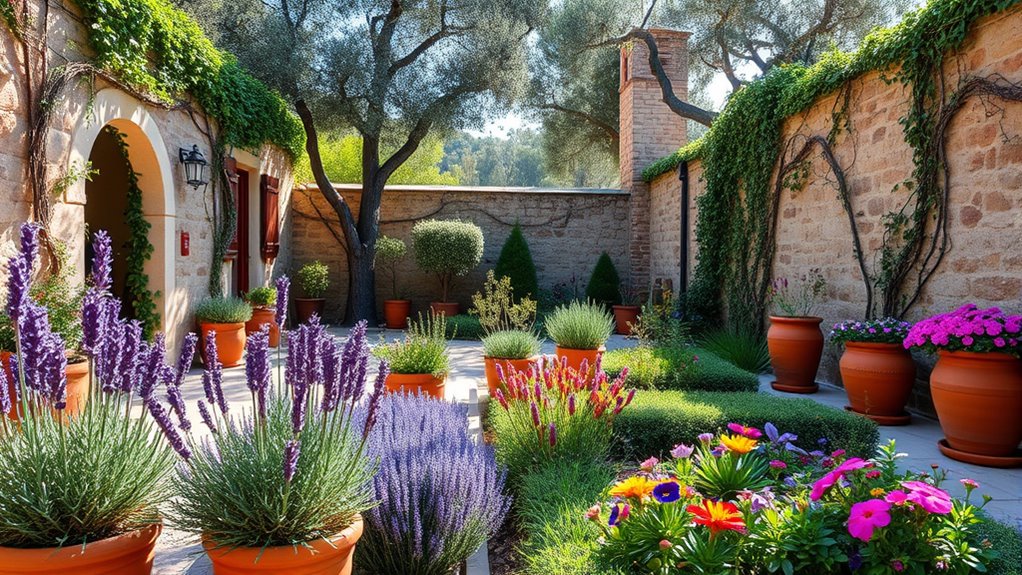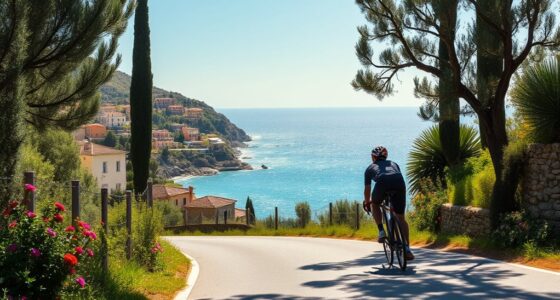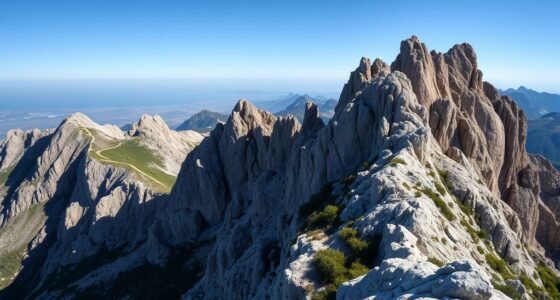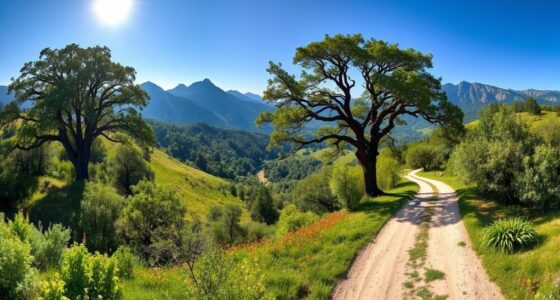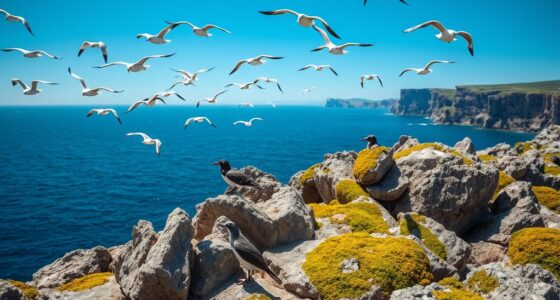Incorporating Sardinian plants into your yard creates a resilient, low-maintenance garden perfect for Mediterranean climates. Choose native species like cork oaks, mastic trees, and endemic shrubs that tolerate drought and thrive in sandy or calcareous soils. Use efficient watering methods, mulch, and group plants by water needs to reduce effort. To learn more about selecting, planting, and caring for Sardinian flora, continue exploring strategies to enhance your landscape sustainably.
Key Takeaways
- Select endemic Sardinian plants like Cephalaria squamiflora and Ferula arrigonii that are adapted to local Mediterranean conditions.
- Use drought-resistant species such as Olea europaea and Pistacia lentiscus to minimize water needs.
- Incorporate organic mulch and drip irrigation to maintain soil moisture and reduce maintenance.
- Group plants by water and sunlight requirements for efficient watering and healthy growth.
- Mimic natural Sardinian habitats with well-draining soils and microclimates to help native plants thrive.
Discovering Sardinian Native Trees and Shrubs for Your Garden

If you’re looking to create a garden that thrives with minimal water and supports local biodiversity, incorporating Sardinian native trees and shrubs is an excellent choice. Start with evergreen trees like the mastic tree (Pistacia lentiscus), which tolerates drought and adds structure. The cork oak (Quercus suber) offers insulation with its thick bark and grows well in sandy, acidic soils. For cooler microclimates, holly (Ilex aquifolium) provides glossy foliage and habitat for fauna. The European yew (Taxus baccata) offers shade and a traditional touch, while the Mediterranean olive (Olea europaea) adapts to dry conditions and low water. Pair these with drought-resistant shrubs like oleander and native species such as Cephalaria squamiflora for a sustainable, biodiverse garden. Sardinian endemic plant species include several varieties that are well-suited for native gardening. Incorporating plants with drought tolerance can further ensure the resilience and sustainability of your garden.
Selecting Endemic Plants Adapted to Mediterranean Climates

Choosing endemic plants adapted to Mediterranean climates guarantees your garden thrives naturally with minimal water and maintenance. Sardinia’s native flora includes 341 endemic taxa, many suited to dry, hot summers and mild, wet winters. Focus on species like *Ptychotis sardoa*, *Valeriana amazonum*, and *Cephalaria squamiflora*, which thrive in calcareous soils common in Sardinia. These plants are drought-resistant and tolerant of nutrient-poor soils, reducing irrigation and fertilization needs. Incorporate species from habitats like limestone karstic areas or Mediterranean shrublands, such as *Ferula arrigonii* or *Cymbalaria muelleri*. Many endemics have deep roots or water-storing adaptations, making them ideal for xeric landscapes. Endemic plants are often highly adapted to local soil and climate conditions, ensuring their survival even in challenging environments. Selecting these plants ensures your yard aligns with local biodiversity , supports ecological resilience, and maintains a sustainable, low-maintenance Mediterranean garden.
Designing a Low-Maintenance, Drought-Resistant Landscape

Designing a low-maintenance, drought-resistant landscape requires strategic planning to optimize water use and reduce upkeep. Start by installing drip irrigation systems that deliver water directly to plant roots, minimizing evaporation and runoff. Mulch with organic materials like bark or compost around plants to retain soil moisture and suppress weeds, reducing watering needs. Use soil moisture sensors and timed irrigation schedules during early morning or late evening to prevent water loss. Incorporate rainwater harvesting systems to supplement irrigation with minimal environmental impact. Prepare soil with good drainage, adding organic matter to improve water retention without causing waterlogging. Group plants with similar water needs and position drought-tolerant species in sun-exposed areas. Keep planting arrangements open, avoiding dense planting to reduce humidity and disease risk, ensuring a sustainable, low-maintenance garden.
Incorporating Sardinian Flora for Aesthetic and Functional Benefits

Incorporating Sardinian flora into your landscape enhances both its visual appeal and ecological value. These plants bring diverse forms and colors, like the silvery leaves of *Senecio vira-vira* and the vibrant blue blooms of *Limonium perezii*, creating striking textures and color schemes. Their seasonal flowering, such as *Malva subovata*, provides year-round interest, while iconic plants like *Ferula arrigonii* add vertical drama. Native shrubs like *Phillyrea angustifolia* form dynamic, wind-pruned shapes, enriching garden structure. Supporting local ecosystems beyond aesthetics, Sardinian plants support local ecosystems by attracting pollinators, stabilizing soil, and reducing the need for chemicals. Their drought tolerance and resilience make them ideal for sustainable gardening, promoting ecological balance, blending beauty and function while fostering a healthier, more vibrant landscape.
Tips for Growing and Caring for Sardinian Endemics in Non-Native Settings

To successfully grow Sardinian endemics outside their native habitat, you need to understand their specific environmental needs and adapt your gardening practices accordingly. Start by selecting species suited to your climate and soil. Then, follow these tips:
- Use well-draining soils that mimic rocky or sandy Sardinian substrates to prevent root rot. Proper drainage is essential to replicate their natural conditions and promote healthy growth.
- Replicate Mediterranean conditions by providing hot, dry summers and mild, wet winters.
- Gradually harden seedlings to improve survival during transplanting, avoiding sudden changes.
- Monitor watering carefully, ensuring moisture without waterlogging, especially in summer.
- Consider soil type preferences like calcareous or metalliferous substrates, which are common in Sardinian native habitats, to better support plant health. Native soil conditions are crucial for plant adaptation and growth. Additionally, adjust microhabitats, such as light and water levels, to match natural conditions, giving your Sardinian plants the best chance to thrive.
Frequently Asked Questions
Are Sardinian Endemic Plants Suitable for Container Gardening?
Yes, Sardinian endemic plants are suitable for container gardening because they’re well-adapted to Mediterranean climates, thriving in hot, dry conditions. You should choose plants like *Armeria pungens* or *Helichrysum italicum* for visual interest, ensuring your containers have good drainage and mimic their natural soil. With minimal watering, proper pruning, and full sun exposure, these resilient plants will flourish and add unique beauty to your garden.
How Do I Prevent Pests From Damaging Native Sardinian Species?
To prevent pests from damaging native Sardinian species, start by regularly monitoring pest populations to catch issues early. Use cultural practices like crop rotation, companion planting, and physical barriers to deter pests naturally. Introduce beneficial insects such as ladybugs or parasitic wasps to control pests biologically. Combine these methods with targeted, environmentally friendly treatments when needed, and stay adaptable to seasonal changes to maintain healthy, pest-free plants.
Can Sardinian Plants Survive Cold Winter Temperatures Outside Sardinia?
You wonder if Sardinian plants can survive cold winters outside Sardinia. Since these plants mostly thrive in USDA Zone 9b, they’re sensitive to prolonged freezing temperatures below -4°C. To help them survive, you can create microclimates, use frost covers, and mulch, or bring tender plants indoors. Keep an eye on your local minimum temperatures and provide extra protection when cold snaps hit, ensuring your plants’ survival.
What Are the Best Soil Amendments for Endemic Sardinian Plants?
You’re asking about soil amendments for Sardinian endemics—because, of course, they thrive in perfect, nutrient-rich soils, right? Actually, these plants prefer poor, calcareous soils with high pH, so you’ll want to add well-aged compost sparingly, use native leaf litter, and incorporate biochar for moisture. Avoid over-fertilizing or heavy amendments, and keep soil well-drained. Think natural, minimal, and mimic their native rocky, dry environment to keep them happy.
Are There Any Legal Restrictions on Collecting Native Sardinian Plants?
You should know there are strict legal restrictions on collecting native Sardinian plants. You need permits before harvesting any wild plants or seeds, especially in protected areas or reserves. Local laws and regional regulations aim to conserve endangered species like *Ribes sardoum*. Violating these rules can lead to hefty fines or legal action. Always verify the plant’s legal status and source from authorized nurseries to stay compliant and support conservation efforts.
Conclusion
By choosing Sardinian native plants, you bring a touch of Mediterranean resilience and beauty to your yard. These hardy, drought-resistant species not only thrive with less maintenance but also create a unique, vibrant landscape. Why settle for ordinary when you can craft a sustainable, eye-catching garden full of endemic charm? Embrace Sardinian flora, and watch your outdoor space flourish with minimal effort and maximum impact. Isn’t it time to transform your garden into a Mediterranean oasis?
